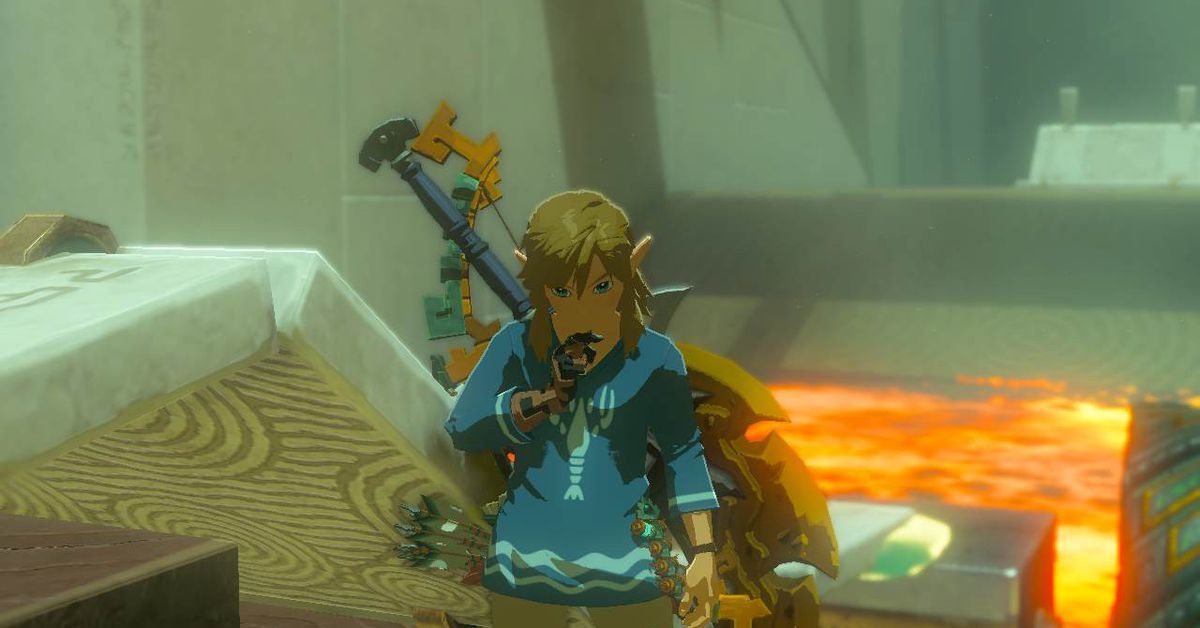Tears of the Kingdom’s bridge physics are impressive
There’s a bridge to cross the lava pit in The Legend of Zelda: Tears of the Kingdom’s Marakuguc Shrine, but it’s broken. More than half of the bridge is piled on top of itself on one side of the pit, with one clipped-off segment on the other. The bridge is the obvious choice for crossing the lava, but how to fix it?
A clip showing one potential solution went viral on Twitter shortly after Tears of the Kingdom’s release: The player uses Link’s Ultrahand ability to unfurl the stacked bridge by attaching it to a wheeled platform in the lava. When the wheeled platform — now attached to the edge of the bridge — activates and moves forward, it pulls the bridge taut, splashing lava as it goes, until the suspension bridge is actually suspended and can be crossed. But it wasn’t the solution itself that resonated with players; instead, the clip had game developers’ jaws on the ground, in awe of how Nintendo’s team wrangled the game’s physics system to do that.
To players, it’s simply a bridge, but to game developers, it’s a miracle.
The game programming flex of all time. pic.twitter.com/id2K5uE5mz — William Armstrong (@WillWArmstrong) May 21, 2023
“The most complicated part of game development is when different systems and features start touching each other,” said Shayna Moon, a technical producer who’s worked on games like the 2018 God of War reboot and its sequel, God of War: Ragnarök, to Polygon. “It’s really impressive. The amount of dynamic objects is why there are so many different kinds of solutions to this puzzle in particular. There are so many ways this could break.”
Moon pointed toward the individual segments of the bridge that operate independently. Then there’s the lava, the cart, and the fact you can use Link’s Ultrahand ability to tie any of these things together — even the bridge back onto itself.
Nintendo reportedly used a full year of Tears of the Kingdom’s development for polish, and it shows. “The amount of different options available is a testament to the amount of work that every single person at every level of the team did, especially the QA testers,” Moon said. “Open-world games with a ton of real-time physics objects like this are notoriously difficult to QA test.”
Another big game that inspired this sort of physics-based shock and awe from game developers on social media was in 2020, when The Last of Us Part 2 included a rope necessary for solving a puzzle. Like Tears of the Kingdom’s bridge, the rope and its natural-seeming movements were just something players expected to work, but game developers could see how much work went into the development of it.
“Last time I saw something this impressive physics/gameplay wise was the rope in The Last of Us Part 2”
The bridge has a ton of different points that are pulling on each other within the physics system, said Luna Nielsen, a software engineer who goes by Luna the Foxgirl online and livestreams about the complexities of game engines. “It gets into some pretty mathy stuff. It can get really funky when something pulls a bit too much, and suddenly the bridge is inside of itself. So it has to push it out. And then one thing has moved too far back. It starts getting really bad, because [the pieces of the bridge] basically are distinct from each other’s movements.”
Software engineer Cole Wardell put it another way: “Imagine the lava bridge above, when you grab the end of it, you pull part of it to one side,” he said. “Well, now that drags the other attached piece a little bit with it, and that piece moving makes the next piece move, and so on and so forth. And if any one element of the track collides with something, it has to be nudged or slid back into somewhere that doesn’t collide, which moves the pieces next to it which moves the pieces next to it.”
“Last time I saw something this impressive physics/gameplay wise was the rope in The Last of Us Part 2. And the rope only appeared in [a] few very controlled scenarios,” said Rocksteady Games senior gameplay and combat programmer Aadit Doshi on Twitter. “To be able to confidently present the player with a stack of blocks that are linked with chains that move in accurate ways, without clipping, without objects shaking like crazy as it tries to figure out what it needs to do is awe-inspiring.”
Tears of the Kingdom also has its own rope-like physics flex: Another viral clip showed a door opening using four wheels and a chain. That’s a complex interaction that takes no shortcuts, Wardell told Polygon. “As a rule, physics engines take a lot of shortcuts and make a lot of assumptions, both for optimization purposes and to keep developers from pulling their own hair out,” Wardell said. “Almost all of these shortcuts, whether it be collision-free ropes [or] rotating objects only applying forces in specific ways, would make this kind of mechanism flat-out not work, or the chain start vibrating until it disappears from view in a single frame, or some other infamous physics glitch.”
He said that rope bugs “vibrating out of control” are so common because of these problems. “If you don’t do everything just right, one movement will cause the other parts of the rope to move, and their movement will cause more collisions — God forbid you want the rope to collide with itself. Those collisions will cause more nudges, which is more movement, which ends up with your robe vibrating out of the map.”
Doshi explained that complex physics are common in games, but said that Tears of the Kingdom pushes the limits of its engine to create exceptional gameplay and puzzles. “Realistic physics simulations take hours to do calculations to make sure it is highly precise and accurate,” he said. “Game physics needs to produce similar results every 16-32 milliseconds (60-30 frames per second).”
Some games are able to avoid these complexities by designing around them, Doshi said. That means restricting player action, which is the antithesis of Tears of the Kingdom’s design. There are constraints, but somehow, in this game, it still feels like nothing is off-limits.
“In game development, it’s not if physics will break down but when,” Gravity Well senior engineer and former Call of Duty developer Josh Caratelli told Polygon. That’s why there’s a whole Reddit page about physics goofs — player characters ragdolling into oblivion or enemies bouncing off the walls. It’s not that games with physics bugs or glitches are poorly made; it’s just really easy for things to go wrong.
Caratelli stressed, however, that Tears of the Kingdom’s physics are not magic — it’s clear that Nintendo greatly understands the physics interactions in the game. “What’s extremely technically impressive is how stable it is and how it all fits together in a way where there’s no pre-programmed solution and players can solve puzzles with complete freedom,” Caratelli added.
Moon noted that it’s not exactly that other studios can’t reach this level of technical innovation, but that they don’t prioritize the resources needed to do it. Often, that comes down to supporting the humans who make the games we play. Tears of the Kingdom was seemingly built on top of Breath of the Wild, reportedly with a large portion of the same team working on it.
“If you want good games, you have to give a damn about the people making them”
“There is a problem within the games industry where we don’t value institutional knowledge,” Moon said. “Companies will prioritize bringing someone from outside rather than keeping their junior or mid-level developers and training them up. We are shooting ourselves in the foot by not valuing that institutional knowledge. You can really see it in Tears of the Kingdom. It’s an advancement of what made Breath of the Wild special.”
According to Moon, it’s increasingly common for game developers to feel like they’re holding some feature or another together with duct tape, figuratively speaking, after the person who originally spearheaded its design got laid off or left; there’s a lot of time wasted reconfiguring and assessing how something was done. It’s not that Nintendo doesn’t have its own problems, because it certainly does — Nintendo of America QA testers spoke out about a “frat house” experience within Nintendo of America’s Washington headquarters last year, for instance. But the company does appear to value the expertise of its development staff.
“In addition to the overall hard work of the team, the institutional knowledge is clearly a factor in why this ended up being so smoothly done,” Moon said. “The more stable and happy people are, the more they are able to make games of this quality. If you want good games, you have to give a damn about the people making them.”
Source: Polygon


